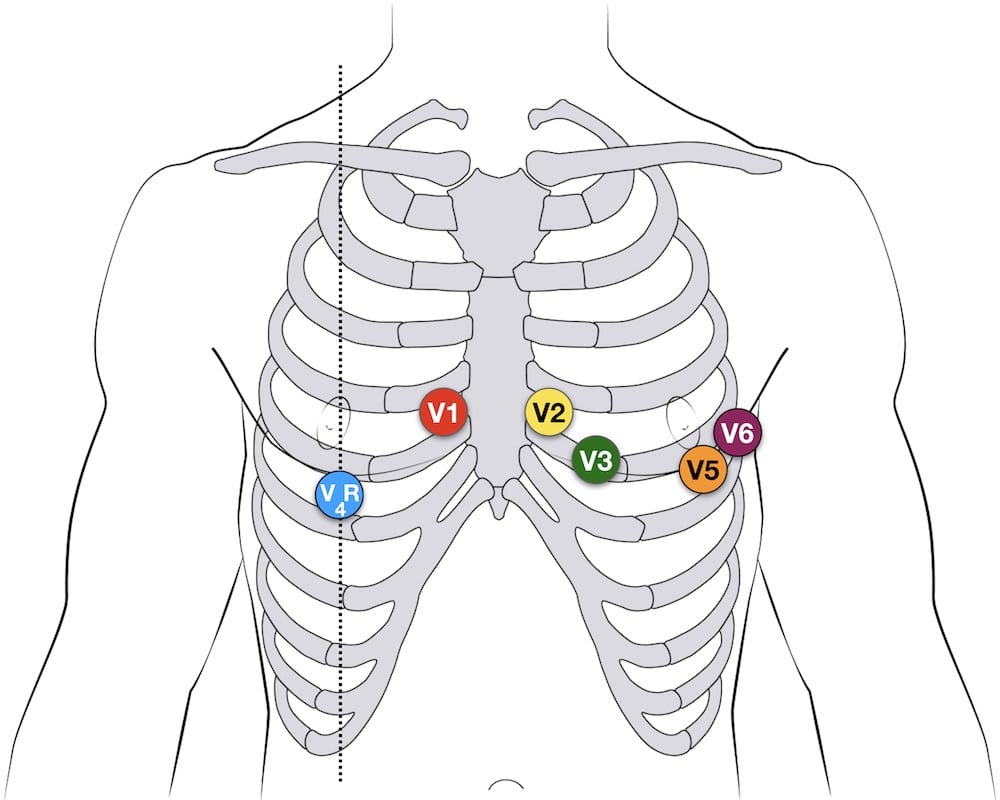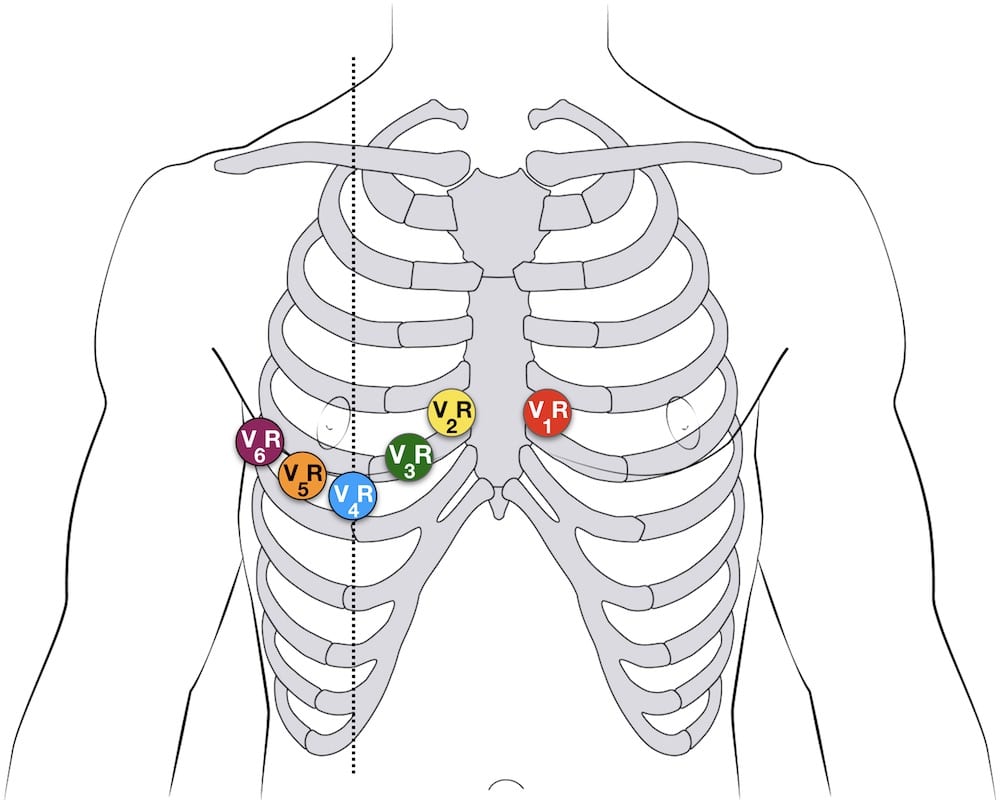Aside from a 12-lead ECG placement theres something known as a 15-lead placement which includes placing leads V4-V6 on the posterior side of the patient below their left scapula see below. A prehospital 12-lead ECG may be initiated and performed on scene but should not extend scene time.

The Ultimate 12 Lead Ecg Placement Guide With Illustrations
ST-elevation myocardial infarction STEMI is suspected when a patient presents with persistent ST-segment elevation in 2 or more anatomically contiguous ECG leads in the context of a consistent clinical history.

. The overwhelming majority of studies regarding both the diagnostic and prognostic utility of adding posterior and right-sided leads date from the late 1970s to early 2000s. Ensure the trainer is clean. Right sided 12 lead ECG lead placement.
That is a time when thrombolysis was the mainstay of reperfusion therapy with diagnostic ST-elevation. On most EKg machines the labels areno automatically changed so it is important to cross out the labels for V4-V6 and write in V7-V9. In addition the use of the 15-lead ECG confirms the posterior MI and is superior to the findings in the anterior leads.
Basic 12-Lead Placement 1. V4 At the mid-clavicular line in the fifth intercostal space. Feel for anatomical landmarks on trainer remove electrode from sheet and place adhesive side.
A complete set of right-sided leads is obtained by placing leads V1-6 in a mirror-image position on the right side of the chest see diagram below. Electrodes Placement for Posterior Leads. Isolated posterior MI is less common 3-11 of infarcts.
You suspect that the underlying cause of a patients presentation is cardiac eg. It is also helpful for future clinicians if you note in your read that it is a posterior ECG. 2 patients among the 50 had both RVI and PWMI.
Posterior extension of an inferior or lateral infarct implies a much larger area of myocardial damage with an increased risk of left ventricular dysfunction and death. Posterior infarction accompanies 15-20 of STEMIs usually occurring in the context of an inferior or lateral infarction. Position trainer in the desired upright or horizontal position.
Lead Placement for Posterior ECG Resus Review. While the 18-lead ECG is perhaps more sensitive for early detection of ischemia or infarction in practice either should be used for. V3 Midway between locations V2 and V4.
Doing a 15 lead ECG Firstly do a standard ECG then by repositioning leads V4 V5 and V6 to the patients back they become V7 V8 and V9. When viewing the EKG strip V4-V6 on the strip will be referred to as V-13-15. When viewing the EKG strip V4-V6 on the strip will be referred to as V-13-15.
Enter the patients name and date of birth for all 12- leads day 2 month 3 year 4 on the cardiac monitor if the day is a single digit do not preface with. V2 Fourth intercostal space next to the sternum on the left side. V4V7 V5V8 and V6V9.
Total scene time should not exceed 20 minutes. 4-5 Indications of a posterior wall infarction may include. Isolated posterior MI is less common 3-11.
15-lead ECG V4R V8 V9 So why arent these leads in our default ECG acquisition. Aside from a 12-lead ECG placement theres something known as a 15-lead placement which includes placing leads V4-V6 on the posterior side of the patient below their left scapulasee below. To clarify leads will equal.
When a 15-lead or 18-lead ECG machine is not available manipulation of the leads from a standard 12-lead ECG machine allow additional areas of the heart to be imaged. ECG Monitoring 12 -Lead. It can be simpler to leave V1 and V2 in their usual positions and just transfer leads V3-6 to the right side of the chest ie.
The standard ECG coupled with these additional leads constitutes the 15-lead ECG the most frequently used additional lead ECG in clinical practice. Lead ECG taken from 50 IWMI patient s the overall incidence of ST elevation in the posterior chest. With the conventional 12 lead ECG in patients presenting with suspected Posterior Myocardial Infarction PMI To determine the utility of 15-lead ECG in the.
In this series of 15 -. Posterior leads are helpful in suspected posterior myocardial infarction. See figures 8 9 3.
How many electrodes are placed on the back when conducting a posterior EKG. Lay out labeled leads and plug them into their designated outlets on the 15-lead electronics box. Nicole Gamblin Alissa Graft Holly Krause Faith Metzinger Sam Parmenter Jenna Quill Molly Reasner Brittany Rowe Allison Silver Jessie Tucek Objective s8 To determine the effect of utilizing additional leads.
A posterior wall MI even though the initial 12 lead ECG shows no obvious acute changes The fact that it doesnt directly show up on a standard 12 lead ECG is the reason the posterior wall MI is the most. Aside from a 12-lead ECG placement theres something known as a 15-lead placement which includes placing leads V4-V6 on the posterior side of the patient below their left scapula see below. Where do you place a 15 lead ECG.
There are three situations where a 15 lead ECG should be performed after a 12 lead ECG. Besides the incidence of isolated posterior MI is not defined and has been reported in studies ranging from 0 to 7-12 18 23. 15 or 18 lead ECGs can be done with alternate precordial lead placement to assess for posterior- or right-sided disease.
Posterior infarction accompanies 15-20 of STEMIs usually occurring in the context of an inferior or lateral infarction. Aside from a 12-lead ECG placement theres something known as a 15-lead placement which includes placing leads V4-V6 on the posterior side of the patient below their left scapula see belowProper 12-Lead ECG Placement. Additional leads frequently used include leads V 8 and V 9 which image the posterior wall of the left ventricle and lead V 4R which reflects the status of the right ventricle.
Proper 12-Lead ECG Placement. Ill do a right 15 or 18 lead if Im really suspicious of something cardiac going on but cant immediately find it on a 12 lead or if I see an inferior wall MI. In the fifth intercostal space and the left posterior axillary line.
Lead Electrode Placement15 lead Preparation and Placement V1 Fourth intercostal space next to the sternum on the right side. Leads V7-V9 was 26. They are performed by placing V4 V5 and V6 electrodes in the same intercostal space but continuing into the patients back.
The leads V4-V6 are removed and substituted for V7-V9 as shown below. ECG Monitoring 1215 Lead PlacementResources. The last time I did a posterior EKG was on a guy who told me he last had a posterior wall MI.
Lead Placement for Posterior ECG.

Diagnostics Alternative Ekg Leads Taming The Sru

Ecg Lead Positioning Litfl Ecg Library Basics

Ecg Lead Positioning Litfl Ecg Library Basics

12 15 Lead Ecg Lead Placement Youtube
Lead Placement For Posterior Ecg Resus Review

Ecg Lead Positioning Litfl Ecg Library Basics
Emdocs Net Emergency Medicine Educationposterior Mi Recognition Emdocs Net Emergency Medicine Education

0 comments
Post a Comment